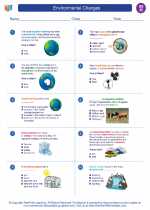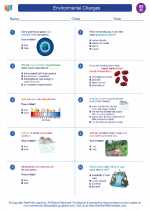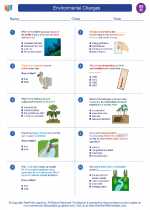Environmental Changes
The issue of global warming has been the cause of much debate in the past fifty years. Greenhouse gases, overpopulation, fossil fuel usage, and deforestation have been at the top of the list of reasons that the world’s environment is changing for the worse. Many plants and animals are becoming extinct due to these environmental changes. Industrialization and overpopulation have caused a decrease in land available for other species. Read More...
◂Social Studies Worksheets and Study Guides Eighth Grade. Environmental Changes
Study Guide Environmental Changes
Environmental Changes  Worksheet/Answer key
Worksheet/Answer key Environmental Changes
Environmental Changes  Worksheet/Answer key
Worksheet/Answer key Environmental Changes
Environmental Changes  Worksheet/Answer key
Worksheet/Answer key Environmental Changes
Environmental Changes 

 Worksheet/Answer key
Worksheet/Answer key
 Worksheet/Answer key
Worksheet/Answer key
 Worksheet/Answer key
Worksheet/Answer key

The resources above cover the following skills:
National Curriculum Standards for Social Studies (NCSS)
TIME, CONTINUITY, AND CHANGE
SOCIAL STUDIES PROGRAMS SHOULD INCLUDE EXPERIENCES THAT PROVIDE FOR THE STUDY OF THE PAST AND ITS LEGACY.
KNOWLEDGE - Learners will understand:
Concepts such as: chronology, causality, change, conflict, complexity, multiple perspectives, primary and secondary sources, and cause and effect.
PEOPLE, PLACES, AND ENVIRONMENTS
SOCIAL STUDIES PROGRAMS SHOULD INCLUDE EXPERIENCES THAT PROVIDE FOR THE STUDY OF PEOPLE, PLACES, AND ENVIRONMENTS.
KNOWLEDGE - Learners will understand:
The theme of people, places, and environments involves the study of the relationships between human populations in different locations and geographic phenomena such as climate, vegetation, and natural resources.
Past and present changes in physical systems, such as seasons, climate, and weather, and the water cycle, in both national and global contexts.
Human modifications of the environment.
PROCESSES - Learners will be able to:
Acquire, organize, and analyze information and use geographic tools to draw conclusions about historic or current national and global environmental change.
Evaluate the consequences of human actions in environmental terms.
GLOBAL CONNECTIONS
SOCIAL STUDIES PROGRAMS SHOULD INCLUDE EXPERIENCES THAT PROVIDE FOR THE STUDY OF GLOBAL CONNECTIONS AND INTERDEPENDENCE.
KNOWLEDGE - Learners will understand:
Spatial relationships that relate to ongoing global issues (e.g., pollution, poverty, disease, and conflict) affect the health and well-being of Earth and its inhabitants.
Global problems and possibilities are not generally caused or developed by any one nation.
PROCESSES - Learners will be able to:
Explore the causes, consequences, and possible solutions related to persistent, current, and emerging global issues, such as health, resource allocation, economic development, and environmental quality.
National Standards for Civics and Government (NSCG)
What is the relationship of the United States to other nations and to world affairs? How is the world organized politically?
International organizations. Students should be able to explain the role of major international organizations in the world today. To achieve this standard, students should be able to
Describe the purposes and functions of major governmental international organizations, e.g., UN, NATO, OAS, World Court
National Content Standards in Economics (NCSE)
Decision Making
Students will understand that effective decision making requires comparing the additional costs of alternatives with the additional benefits. Many choices involve doing a little more or a little less of something: few choices are “all or nothing” decisions. Students will be able to use this knowledge to make effective decisions as consumers, producers, savers, investors, and citizens.
At the completion of Grade 8, students will use this knowledge to:
Apply the concepts of marginal benefit and marginal cost to reducing pollution.
National Center for History in Schools (NCHS)
Historical Thinking Standards
Historical Analysis and Interpretation
Analyze cause-and-effect relationships and multiple causation, including the importance of the individual, the influence of ideas.
World History Content Standards
Era 9: The 20th Century Since 1945: Promises and Paradoxes
The search for community, stability, and peace in an interdependent world.
The student understands how population explosion and environmental change have altered conditions of life around the world.
Major global trends since World War II.
The student understands major global trends since World War II.